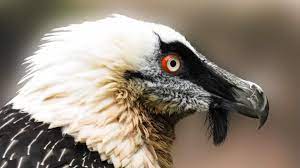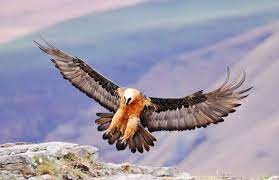The Bearded Vulture, also known as the Lammergeier or ossifrage, is a remarkable bird of prey that captivates bird enthusiasts and conservationists alike. This magnificent species, which boasts a wingspan of up to 9 feet, is truly a marvel of nature. In this article, we’ll delve into 65 intriguing facts about the
Bearded Vulture that will leave you awestruck.

1. Habitat Diversity: Bearded Vultures are found in some of the world’s most challenging terrains, from the rugged Himalayas to the African mountains.
2. Iconic Appearance: Their striking appearance includes a beard-like feature made of feathers around their beak.
3. Impressive Wingspan: Bearded Vultures have one of the largest wingspans among all vulture species.
4. Bone-Eating Specialists: They are known for their unique diet, which primarily consists of bones.
5. Bone-Dropping Technique: Bearded Vultures drop bones from high altitudes to crack them open and access the marrow.
6. Nesting Sites: They often build nests in cliffside caves, adding to their mystique.
7. Feathered Feet: These vultures have feathers on their legs, an adaptation to help regulate their body temperature.
8. Conservation Efforts: Bearded Vultures are a conservation success story, with dedicated efforts to protect their populations.
9. Monogamous Pairs: They form long-term monogamous pairs and share parenting responsibilities.
10. Migratory Behavior: Some populations undertake seasonal migrations in search of food.
11. Historical Significance: Bearded Vultures have been revered and feared in various cultures throughout history.
12. Powerful Beaks: Their strong beaks are perfectly adapted for breaking bones.
13. Social Creatures: Bearded Vultures are social birds and often seen in groups, called wakes.
14. Incubation Period: Females incubate the eggs for about 50 days.
15. Slow Reproduction: These birds have a low reproductive rate, making conservation efforts critical.
16. Plumage Variation: Bearded Vultures exhibit variations in plumage color, from reddish-brown to nearly white.
17. Nest Decorations: They decorate their nests with colorful objects like bones and stones.
18. High-Altitude Soaring: Bearded Vultures are skilled gliders, often soaring at high altitudes for hours.
19. Longevity: In captivity, they can live up to 45 years, though the wild lifespan is shorter.
20. Alpine Skiers: They are sometimes observed flying near ski resorts, utilizing updrafts.

21. Symbolic Importance: In some regions, they are considered symbols of power and freedom.
22. Courtship Rituals: Intricate aerial displays are part of their courtship rituals.
23. Importance in Ecosystem: They play a crucial role in scavenging and cleaning up carcasses.
24. Protected Species: Bearded Vultures are legally protected in many countries.
25. Vocalizations: They communicate through a series of hisses and squeals.
26. Conservation Partnerships: Organizations worldwide collaborate to protect these vultures.
27. Evolutionary Adaptations: Their unique diet and bone-cracking abilities have evolved over millions of years.
28. Geographic Range: Bearded Vultures inhabit a wide range of mountainous regions.
29. Flying Skills: They are known for their acrobatic flying, even in challenging mountain winds.
30. Threats to Survival: Habitat loss and poisoning remain significant threats.
31. Sky Burials: In some cultures, Bearded Vultures are associated with sky burials.
32. Cultural Significance: They are revered in Bhutanese culture as “phobia.”
33. Scientific Name: Their scientific name, Gypaetus barbatus, reflects their bearded appearance.
34. Soaring Techniques: They use thermal currents to gain altitude effortlessly.
35. Legendary Myths: Bearded Vultures appear in various myths and legends.
36. Conservation Symbols: These vultures symbolize the importance of preserving biodiversity.
37. Subspecies: There are several subspecies, each with unique characteristics.
38. Long-Term Bonding: Some pairs stay together for life, reinforcing the importance of conservation.
39. Nesting Material: They use materials like bones and wool for nest construction.
40. Caring Parents: Both parents participate in feeding and raising their young.
41. Alpine Wonders: Bearded Vultures are often spotted in alpine environments.
42. Extensive Range: They can cover vast distances in search of food.
43. Adapted Digestive System: Their digestive system can handle bone fragments.

44. Gravity Defying: Their ability to soar at high altitudes showcases their mastery of the skies.
45. Community Involvement: Local communities often play a vital role in their conservation.
46. Threatened Populations: Some populations are critically endangered.
47. Evolutionary Lineage: Bearded Vultures belong to the family Accipitridae.
48. Endangered Status: They are listed as Near Threatened by the IUCN.
49. Mysterious Vultures: They are known for their enigmatic behaviors.
50. Environmental Indicators: The presence of Bearded Vultures can indicate a healthy ecosystem.
51. Unique Feeding Habits: Few birds feed on bones as their primary food source.
52. Niche Role: Bearded Vultures have a niche role as nature’s bone cleaners.
53. Efforts in Europe: European reintroduction programs have boosted their numbers.
54. Cultural Names: They are known by various names in different cultures.
55. Cooperative Hunting: They are occasionally observed hunting in pairs.
56. Wind Rider: Masterful use of air currents aids their efficient foraging.
57. Alpine Symbolism: They are emblematic of pristine alpine environments.
58. Educational Value: Studying Bearded Vultures aids in understanding avian behavior.
59. Local Legends: Many local legends and stories revolve around these vultures.
60. Dietary Preferences: They have a preference for the bones of large herbivores.
61. Awareness Campaigns: Conservation organizations run campaigns to protect them.
62. Slow Breeders: Bearded Vultures reproduce slowly due to their extended parental care.
63. Poaching Dangers: They face risks from illegal wildlife trade.
64. Wing Design: Their wings are uniquely shaped for efficient gliding.
65. Flagship Species: Bearded Vultures serve as flagship species for biodiversity conservation.
In conclusion, the Bearded Vulture stands as a testament to the marvels of nature, captivating us with its unique adaptations, behavior, and cultural significance. As we celebrate these 65 fascinating facts, let us remember the importance of conserving this magnificent species and the fragile ecosystems they inhabit.



















Add Comment